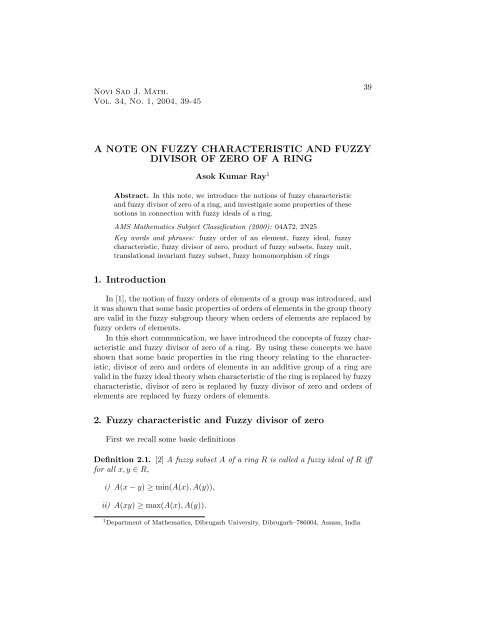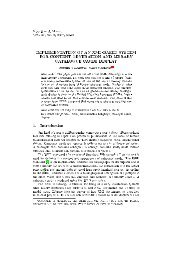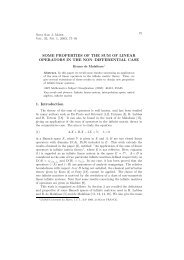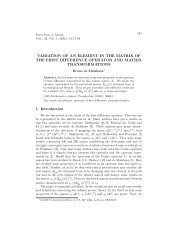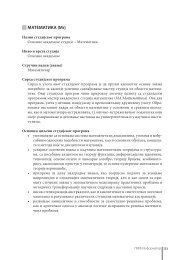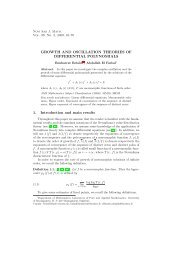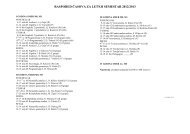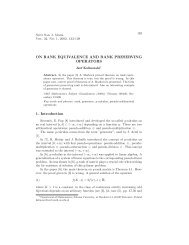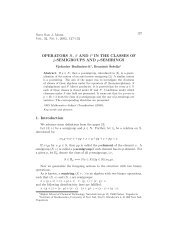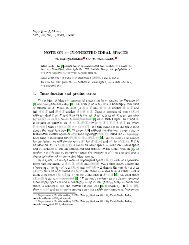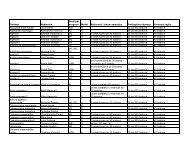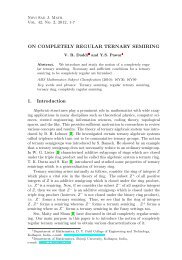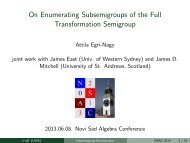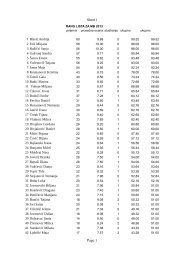A note on fuzzy characteristic and fuzzy divisor of zero of a ring
A note on fuzzy characteristic and fuzzy divisor of zero of a ring
A note on fuzzy characteristic and fuzzy divisor of zero of a ring
- No tags were found...
Create successful ePaper yourself
Turn your PDF publications into a flip-book with our unique Google optimized e-Paper software.
A <str<strong>on</strong>g>note</str<strong>on</strong>g> <strong>on</strong> <strong>fuzzy</strong> <strong>characteristic</strong> . . . 433. Fuzzy Homomorphism <strong>and</strong> Fuzzy IsomorphismMordes<strong>on</strong> <strong>and</strong> Malik [3] introduced the c<strong>on</strong>cepts <strong>of</strong> <strong>fuzzy</strong> homomorphisms<strong>and</strong> <strong>fuzzy</strong> isomorphisms <strong>of</strong> <strong>ring</strong>s as follows:Let θ ∈ [0, 1).Let R <strong>and</strong> S be n<strong>on</strong>empty sets. C<strong>on</strong>sider the following c<strong>on</strong>diti<strong>on</strong>s <strong>on</strong> a <strong>fuzzy</strong>subset f <strong>of</strong> the Cartesian product R × S:(1) ∀x ∈ R, ∃y ∈ S such that f(x, y) > θ;(2) ∀y ∈ S, ∃x ∈ R such that f(x, y) > θ;(3) ∀x ∈ R, ∀y 1 , y 2 ∈ S, f(x, y 1 ) > θ <strong>and</strong> f(x, y 2 ) > θ implies y 1 = y 2 ;(4) ∀x 1 , x 2 ∈ R, ∀y ∈ S, f(x 1 , y) > θ <strong>and</strong> f(x 2 , y) > θ implies x 1 = x 2 .Let f be a <strong>fuzzy</strong> subset <strong>of</strong> R × S. If c<strong>on</strong>diti<strong>on</strong>s (1) <strong>and</strong> (3) hold, then f iscalled a <strong>fuzzy</strong> functi<strong>on</strong> <strong>of</strong> R into S. If c<strong>on</strong>diti<strong>on</strong>s (1), (2) <strong>and</strong> (3) hold, then fis called a <strong>fuzzy</strong> functi<strong>on</strong> <strong>of</strong> R <strong>on</strong>to S. If c<strong>on</strong>diti<strong>on</strong>s (1), (3) <strong>and</strong> (4) hold, thenf is called a <strong>on</strong>e-to-<strong>on</strong>e <strong>fuzzy</strong> functi<strong>on</strong> <strong>of</strong> R into S.A <strong>fuzzy</strong> functi<strong>on</strong> f from a <strong>ring</strong> R into a <strong>ring</strong> S is called <strong>fuzzy</strong> homomorphismif <strong>and</strong> <strong>on</strong>ly if∀x 1 , x 2 ∈ R , ∀y ∈ Sf(x 1 + x 2 , y) ≥ sup{min(f(x 1 , y 1 ), f(x 2 , y 2 ) : y 1 , y 2 ∈ S, y = y 1 + y 2 )};f(x 1 x 2 , y) ≥ sup{min(f(x 1 , y 1 ), f(x 2 , y 2 ) : y 1 , y 2 ∈ S, y = y 1 y 2 )}.If a <strong>fuzzy</strong> homomorphism from R <strong>on</strong>to S is <strong>on</strong>e–to–<strong>on</strong>e, then it is called a<strong>fuzzy</strong> isomorphism <strong>of</strong> R <strong>on</strong>to S.Definiti<strong>on</strong> 3.1. Suppose f is a <strong>fuzzy</strong> homomorphism from a <strong>ring</strong> R <strong>on</strong>to a <strong>ring</strong>S <strong>and</strong> A is a <strong>fuzzy</strong> subset <strong>of</strong> R, then f is called a <strong>fuzzy</strong> isomorphism with respectto A iff∀x 1 , x 2 ∈ R , ∀y ∈ Sf(x 1 , y) > 0 <strong>and</strong> f(x 2 , y) > 0 implies A(x 1 ) = A(x 2 ) .Theorem 3.1. Suppose A is a <strong>fuzzy</strong> ideal <strong>of</strong> a <strong>ring</strong> R with identity e such thatA(e) > 0. If F C A (R) is 0, then the additive subgroup <strong>of</strong> R generated by theidentity e is <strong>fuzzy</strong> isomorphic to the integral domain Z <strong>of</strong> all integers.Pro<strong>of</strong>. Let F C A (R) be 0. Then F O A (e) in the additive group <strong>of</strong> R is infinite.Let R ∗ de<str<strong>on</strong>g>note</str<strong>on</strong>g> the additive subgroup <strong>of</strong> R generated by e. Since A is a <strong>fuzzy</strong>ideal <strong>of</strong> R we have 0 < A(e) ≤ A(x) ≤ A(o) for all x ∈ R. We also <str<strong>on</strong>g>note</str<strong>on</strong>g> that
44 A. K. RayA(ne) < A(o) for any n ∈ Z by assumpti<strong>on</strong>. We define a <strong>fuzzy</strong> subset f <strong>of</strong> theCartesian cross-product R ∗ × Z as follows:f(ne, n) = A(ne) for all integers n ∈ Z ,f(ne, m) = 0 for all integers n, m ∈ Z with n ≠ m .From the definiti<strong>on</strong> <strong>of</strong> f it clearly follows that f is a <strong>on</strong>e–to–<strong>on</strong>e <strong>fuzzy</strong> functi<strong>on</strong><strong>of</strong> R ∗ <strong>on</strong>to Z.Let n 1 e, n 2 e ∈ R ∗ <strong>and</strong> n ∈ Z. If n = n 1 + n 2 , thenf(n 1 e + n 2 e, n) = f((n 1 + n 2 )e, n 1 + n 2 ) = A(n 1 e + n 2 e)≥ inf(A(n 1 e), A(n 2 e)) = inf(f(n 1 e, n 1 ), f(n 2 e, n 2 )) .If n ≠ n 1 +n 2 , we suppose n = m 1 +m 2 , where m 1 , m 2 ∈ Z, then either n 1 ≠ m 1or n 2 ≠ m 2 . Let n 1 ≠ m 1 . In this case f(n 1 e + n 2 e), n) = 0 <strong>and</strong> f(n 1 e, m 1 ) = 0<strong>and</strong> so inf(f(n 1 e, m 1 ), f(n 2 e, m 2 )) = 0.Thus we find that ∀n 1 e, n 2 e ∈ R ∗ <strong>and</strong> ∀n ∈ Z,f((n 1 e)(n 2 e), n) ≥≥ sup{inf(f(n 1 e, m 1 ), f(n 2 e, m 2 )) : n = m 1 + m 2 , m 1 , m 2 ∈ Z} .Now if n = n 1 n 2 , thenf((n 1 e)(n 2 e), n) = f((n 1 n 2 )e, n 1 n 2 ) = A((n 1 n 2 )e) = A((n 1 e)(n 2 e))≥ sup(A(n 1 e), A(n 2 e)) = sup(f(n 1 e, n 1 ), f(n 2 e, n 2 )) .If n ≠ n 1 n 2 , suppose n = m 1 m 2 where m 1 , m 2 ∈ Z, then either n 1 ≠ m 1 orn 2 ≠ m 2 . In this case we observe f((n 1 e)(n 2 e), n) = 0 <strong>and</strong> f(n 1 e, m 1 ) = 0, ifn 1 ≠ m 1 . So inf(f(n 1 e, m 1 ), f(n 2 e, m 2 )) = 0. Thus we find that ∀n 1 e, n 2 e ∈ R ∗<strong>and</strong> ∀n ∈ Z,f((n 1 e)(n 2 e), n) ≥≥ sup{inf(f(n 1 e, m 1 ), f(n 2 e, m 2 )) : n = m 1 m 2 , m 1 , m 2 ∈ Z} .Hence f is a <strong>fuzzy</strong> isomorphism <strong>of</strong> R ∗ <strong>on</strong>to Z. Thus the pro<strong>of</strong> is completed. ✷Theorem 3.2. Suppose A is a <strong>fuzzy</strong> ideal <strong>of</strong> a <strong>ring</strong> R with identity e such thatA(e) > 0 <strong>and</strong> A(e) ≠ A(o). If R c<strong>on</strong>tains no <strong>fuzzy</strong> <strong>divisor</strong> <strong>of</strong> <strong>zero</strong> with respectto A <strong>and</strong> F C A (R) ≠ 0, then R ∗ is <strong>fuzzy</strong> isomorphic with respect to A to thefield Zp <strong>of</strong> all integers mod p, for some prime p.Pro<strong>of</strong>. Suppose R c<strong>on</strong>tains no <strong>fuzzy</strong> <strong>divisor</strong>s <strong>of</strong> <strong>zero</strong> with respect to A <strong>and</strong>F C A (R) ≠ 0. Then F C A (R) ≠ 0 is a prime p. Since A(e) ≠ A(o), F O A (e) is p.We define a <strong>fuzzy</strong> subset g <strong>of</strong> the Cartesian cross-product R ∗ × Zp as follows:
A <str<strong>on</strong>g>note</str<strong>on</strong>g> <strong>on</strong> <strong>fuzzy</strong> <strong>characteristic</strong> . . . 45g(me,(n)) = A(ne), where n is the least no–negative integer obtained asremainder when m is divided by p <strong>and</strong> (n)∈ Zp, <strong>and</strong> g(me, (n 1 )) = 0 if n 1 ≠ n,(n 1 )∈ Zp.It can be easily verified that g is a <strong>fuzzy</strong> homomorphism from R ∗ <strong>on</strong>to Zp.If f(m 1 e,(n)) > 0 <strong>and</strong> f(m 2 e,(n)) > 0, then there exist r 1 , r 2 ∈ Z suchthat m 1 = r 1 p + n <strong>and</strong> m 2 = r 2 p + n. This implies that A(m 1 e − m 2 e) =A(((r 1 − r 2 )p)e) = A(o). Which implies that A(m 1 e) = A(m 2 e). Hence f is a<strong>fuzzy</strong> isomorphism with respect to A <strong>of</strong> R ∗ <strong>on</strong>to Zp.✷Acknowledgement. The author is grateful to the referees for their valuable c<strong>on</strong>structivesuggesti<strong>on</strong>s.References[1] Kim, J. G., Fuzzy orders relative to <strong>fuzzy</strong> subgroups. Informati<strong>on</strong> Sciences, 80(1994), 341–348.[2] Liu, W.–J., Fuzzy invariant subgroup <strong>and</strong> <strong>fuzzy</strong> ideals. Fuzzy Sets <strong>and</strong> Systems, 8(1982) 133–139.[3] Malik, D. S., Mordes<strong>on</strong>, J. N., Fuzzy homomorphisms <strong>of</strong> <strong>ring</strong>s. Fuzzy Sets <strong>and</strong>Systems, 46 (1992), 139–146.[4] Novak, V., Fuzzy Sets <strong>and</strong> Their Applicati<strong>on</strong>s. Bristol: Adam Hilger 1989.[5] Ray, A. K., Quotient group <strong>of</strong> a group generated by a subgroup <strong>and</strong> a <strong>fuzzy</strong> subset.Journal <strong>of</strong> Fuzzy Mathematics, 7(2) (1999), 459–463.Received by the editors September 2, 2002


